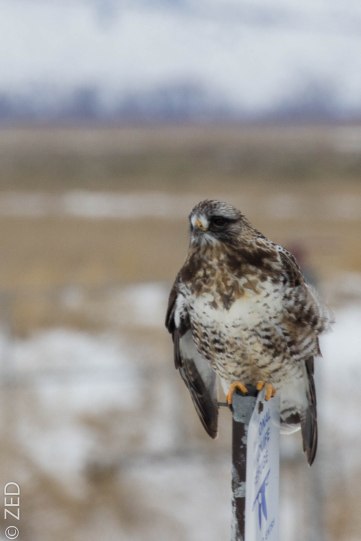Klamath Basin report I

Klamath Basin area with view of Mt McLoughlin in the distant background, a volcano which lies in the Cascade mountain range to the northwest
The Klamath Basin area is home to multiple National Wildlife Refuges (six of them!), and is a major stop-off for migrating water fowl along the Pacific Flyway during the autumn and spring. This flat high desert area (around 4000 feet elevation) straddles the border of Oregon and California and is just east of the Cascade mountain range. It is also host to a lot of agriculture, using waters diverted from the Klamath River to irrigate fields. The Basin sits in view of several volcanoes that are part of the Cascade range, and the area is of volcanic origins. It is truly a magical landscape. Recently it has become even more exciting as there are now two small wolf packs that call the Cascades just west of the Basin home (one of which is the famous OR-7 wolf, who at one point traveled to California and became the first confirmed wolf in CA since the 1930’s)!

Mt McLouglin – volcano in the Oregon Cascade mountain range west of Klamath Basin (photo taken crossing the passes from the Rogue Valley to Klamath Basin – wolf country!!)

snowy pass through the Cascades!
The wetlands themselves are estimated to be only 25% of what they once were, due to appropriation of land and water to agriculture. Many interests share this region, and it is often the subject of debate on how to best share the resources among all them, including Wildlife/Plants, Indigenous People, agriculture, hunters, birders, fishing folks, etc.

Klamath Basin area – open area of the Oregon Straits slough, an ag area that attracts a lot of wildlife

Klamath Basin area – dikes, levies and canals define much of the mostly treeless landscape outside of the National Wildlife areas
During the winter months, there is a very high population of raptors that migrate here to wait out the winter due to the availability of prey (and it should be noted that agriculture fields that are dormant often provide a home to many rodents, thereby attracting more raptors). Here during the winter can be found the highest density population of bald eagles in the continental U.S. outside of Alaska! I have been there previously and seen around 50 eagles in one 360 degree view! Not only that, there are a lot of northern migrants such as rough-legged hawks and ferruginous hawks, species not often seen this far west or south. Those in addition to golden eagles, red-tailed hawks, northern harriers, assorted falcons, many owls and more can be seen here.
I braved some cold temperatures, especially the first day – it was near 0 deg F. A ranger I spoke to said that in the morning he had seen a northern pintail (type of duck) that came out of some reeds and couldn’t get its wings to extend – they had frozen to its body during the night! That’s cold (it eventually did free its wings). Needless to say there weren’t many people out there besides me, but I was able to see some amazing sites and sights (which I’ll highlight over the next few blog posts).
A few of the birds during the trip:

rough-legged hawk / Klamath Basin area CA

golden eagle / Klamath Basin area

northern harrier (female) / Lower Klamath NWR

prairie falcon / Lower Klamath NWR

red-tailed hawk (juvenile) / Klamath Basin area OR

bald eagle / Lower Klamath NWR

rough-legged hawk / Klamath Basin area
My final picture of the first day is a great summary of the area. The sun had set over a half hour before I took this picture – I saw these birds sitting in a tree as I was driving out. My old jeep was not doing a great job of keeping the cold out, but despite my numb fingers and toes I got out to snap this shot. As you can see, the area does not have many trees, so they are coveted by many different birds. Because of the density of prey and lack of trees, often I see multiple species sharing a tree or telephone pole – a necessary truce. The large forms in the tree are a bald eagle on the left, and a red-tailed hawk on the right! They are buddies! At least for the night (usually I see red-tails chasing and harassing bald eagles). Sprinkled among mostly the tree on the left are many red-winged blackbirds as well.

Klamath sunset – tree with bald eagle, red-tailed hawk, and a flock of red-winged blackbirds
Some great resources to learn more about the area:
Winter Wings Festival – http://winterwingsfest.org/
This February weekend (this year it is Feb 11-14 2016) focuses on raptors in the Klamath Basin area and attracts many people to the area. Tours and guides are available, as well as many other events. Definitely worthwhile!!!
http://www.klamathbirdingtrails.com/
http://www.klamathaudubon.org/
http://www.fws.gov/nwrs/threecolumn.aspx?id=2147514481
Lava Beds National Monument is nearby, and Mount Shasta is not far to the south. The whole area is really magical, any time of year.
More to come …

Leave a comment